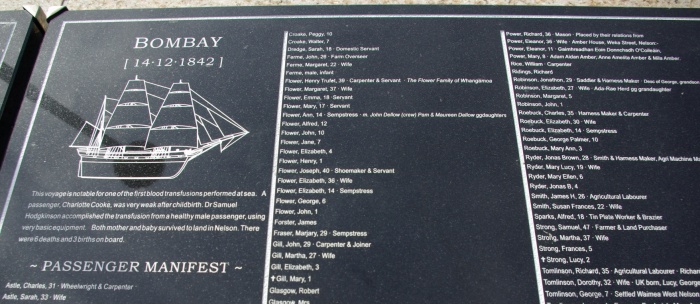BnB HISTORY:
AMBER HOUSE - at the centre!™
Bed and Breakfast Guest House (B&B) in Nelson city centre, New Zealand

House
A German author, W F Buchholz, has written two articles in the on-line encyclopedia called Wikipedia relevant to Amber House.
The first article is entitled Amber House and the second article is about the "School for young ladies and little boys" that started to operate from Amber House one hundred years ago: Cabragh House School
We have been asked by W F Buchholz if we could place on our website some of our very early photographs of Amber House and the School (that are not in the public domain).
We have agreed to try and do this and we are now beginning to print these old negatives and start scanning the prints into GIF and JPEG files. However, we are still trying to work out a scheme that will not impact too much on our allocated bandwidth since some of the scanned files are more than 20 Megabytes in size.
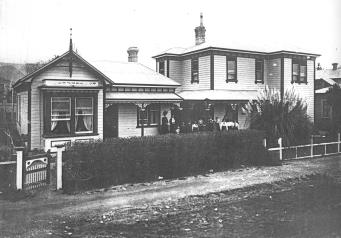 To the right is the first thumbnail of what, at the time this photograph was taken, were two of only three houses in Weka Street.
To the right is the first thumbnail of what, at the time this photograph was taken, were two of only three houses in Weka Street.
The photographer must have been standing at just about the high water mark of Nelson Haven (before extensive land reclamation formed Neale Park) just over 100 years ago.
If you visit Amber House, this photograph is hanging in the entrance hall (just past the Grandfather clock that pre-dates Mr Hornsby's arrival in the Antipodes by nearly 120 years).
The bearded gentleman on the verandah is believed to be Mr John P Hornsby, a Nelson accountant at that time, but who had previously worked on the Irish railways and presumed to have ordered the building of both Amber and Cabragh Houses after he bought land in Weka Street from a Mr Greenem. The Wanganui Chronicle of 10 December 1894 at Page 2 recorded: "Among expected visitors to New Zealand during the coming summer are...J. P. Hornsby, late Assistant Traffic Manager of the Midland Great Western Railway (Ireland). The latter intends to settle in the colony." He had sailed with two of his daughters on the Orient Company's Oroya from London when this was a time of financial depression in New Zealand.
John was an amateur geologist, as his notebooks make clear. An entry from 18th November 1895 is optimistic about the prospects for mining bituminous coal in Nelson and records "Mr McKay only allowed 2 chains for the coal to run from the mine - Mr Worley has traced outcrops from mine to run continuously to Gorge 1 mile". (The Gorge is a deep gully east of the old Enner Glynn workings of Jenkins and the Nelson Coal Company.)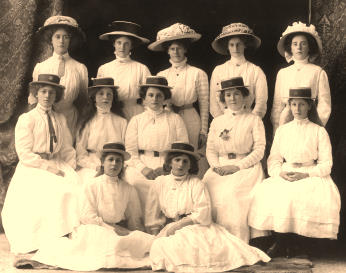 The second thumbnail is a sepia toned print showing a fetching portrait of the "Cabragh House Singing Group"
and it is believed that the then proprietor and headmistress of Cabragh House school, Miss Janetta Hornsby, is in the middle of the back row and her two
sisters, Charlotte and Ruth, flank her on either side.
The second thumbnail is a sepia toned print showing a fetching portrait of the "Cabragh House Singing Group"
and it is believed that the then proprietor and headmistress of Cabragh House school, Miss Janetta Hornsby, is in the middle of the back row and her two
sisters, Charlotte and Ruth, flank her on either side.
This photo is probably contemporaneous with the school bell that was commisioned to celebrate Dominion status for New Zealand more than a century ago that now hangs to the right of our front door.
On 6 July 1899, at page 2, the Colonist recorded in its MARRIAGES column: "April 20th, 1899 at Grosvenor Hall, Dublin, Charles Fraser, only surviving
son of John P. Hornsby, of Nelson, New Zealand (formerly of Dublin), to Marianne Slater (Marie), eldest daughter of H. B. S. Montgomery, C.E.,
5 Elgin Road, Dublin: No cards."
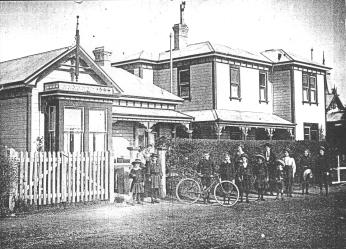 The third thumbnail
is believed to have been taken in 1906 or 1907 by an Australian visitor and was sent in 1982 from Mrs H Haughton of Queensland, Australia. At the right, the
(now demolished) spire of the building that is now Paradiso Backpackers is visible and it can be noted that the three canopies over the second storey front
windows of Amber House have not yet been constructed. A tall vent pipe is now prominent in front of the Blue Room's window and a (still existing) cast iron
soil stack is visible at the north-western corner of Amber House while the pampas grass on the front lawn has been considerably trimmed back.
The third thumbnail
is believed to have been taken in 1906 or 1907 by an Australian visitor and was sent in 1982 from Mrs H Haughton of Queensland, Australia. At the right, the
(now demolished) spire of the building that is now Paradiso Backpackers is visible and it can be noted that the three canopies over the second storey front
windows of Amber House have not yet been constructed. A tall vent pipe is now prominent in front of the Blue Room's window and a (still existing) cast iron
soil stack is visible at the north-western corner of Amber House while the pampas grass on the front lawn has been considerably trimmed back.
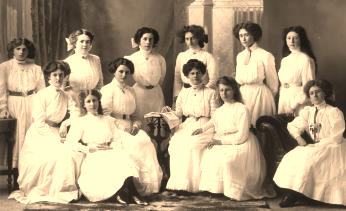 The fourth thumbnail shows a depiction of Miss Janetta Hornsby, her pupils and teachers that is
probably contemporaneous with the second thumbnail - but this time obviously taken in the photographer's studio and without the schoolgirls' fetching straw
boaters.
The fourth thumbnail shows a depiction of Miss Janetta Hornsby, her pupils and teachers that is
probably contemporaneous with the second thumbnail - but this time obviously taken in the photographer's studio and without the schoolgirls' fetching straw
boaters.
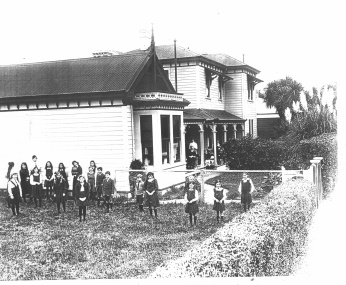 The fifth
thumbnail is of a photograph that was probably taken in about 1911 since the canopies over the three, second storey front windows have now been constructed and
are visible - but there are still no signs of the later second storey balconies. The cabbage tree also seems to have put in a spurt of growth.
The fifth
thumbnail is of a photograph that was probably taken in about 1911 since the canopies over the three, second storey front windows have now been constructed and
are visible - but there are still no signs of the later second storey balconies. The cabbage tree also seems to have put in a spurt of growth.
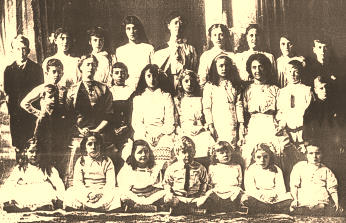 The sixth thumbnail features another Cabragh House School group taken in the same photographer's studio as the fourth thumbnail but the date is uncertain -
although this may well be the last class photograph taken of pupils before Cabragh House School closed in 1928.
The sixth thumbnail features another Cabragh House School group taken in the same photographer's studio as the fourth thumbnail but the date is uncertain -
although this may well be the last class photograph taken of pupils before Cabragh House School closed in 1928.
The Colonist reported on the "Presentation of Prizes at Cabragh House School" on 11 December 1917, commenting: "The roll has increased considerably, and has more than once passed 40 scholars. Most of these are pupils in the standards, but there have always been some older girls, carrying on work to Junior Civil Service and Matriculation; one or two of whom have usually been boarders. We have had pupils from all parts of New Zealand, and even from Australia, ..." and later: "...The school buildings have been enlarged, about five years ago a second house being built, and for the past two years a basket-ball ground adjoining has been leased. After the close of this year, the school will be carried on in the larger house by Miss C. Hornsby (to Standard VI.), and a limited number of boarders will be received..."
The probable reason that the elder Charlotte took over as Principal from her sister was that her younger sister was contemplating matrimony since a Marriage Notice recorded "On 24th June 1918 at Dublin, Frederick G. second son of John Coulter, County Sligo, to Janetta M. youngest daughter of John Hornsby, Nelson...
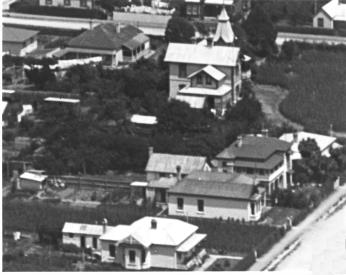 Mr John Pearson Hornsby died less than a year later,
on the 28th of April 1919, aged 85 years and was interred the next day in the same plot in Wakapuaka cemetery as he had bought for his daughter, Ellen, in 1910.
Mr John Pearson Hornsby died less than a year later,
on the 28th of April 1919, aged 85 years and was interred the next day in the same plot in Wakapuaka cemetery as he had bought for his daughter, Ellen, in 1910.
To the right, is a thumbnail of a somewhat blurred enlargement of a photograph taken from the vantage point of the "Centre of New Zealand" ridge that lies just to the east of Amber House.
The foreshore of Nelson Haven is clearly visible in the bottom right hand corner - as are the two newly constructed balconies on the second floor of Amber House. These two observations would date this thumbnail to a date after the armistice signed at Compiègne in La Clairière de l´Armistice ended the Great European War in 1918.
In 1928 Charlotte Hornsby sold Amber House to Henry Canning who discontinued the School but expanded the boarding house side of the business that continues to this day.
Nelson
 Settlement of Nelson began about 1100 years ago by an Indo Malay people (now called Māori
but who were originally from Taiwan by way of the island of Negros in the present day Philippines and then via the North West coastal plains of New Guinea
and the Cook Islands).
Settlement of Nelson began about 1100 years ago by an Indo Malay people (now called Māori
but who were originally from Taiwan by way of the island of Negros in the present day Philippines and then via the North West coastal plains of New Guinea
and the Cook Islands).
There is evidence the earliest human settlements in New Zealand are in the Nelson region.
The earliest recorded iwi in the Nelson district were the Ngati Kuia, Ngati Tumatakokiri, Ngati Apa and Rangitane tribes.
However, raids from northern tribes in the 1820's, led by Te Rauparaha and his Ngati Toa, soon decimated the local population and quickly displaced them.
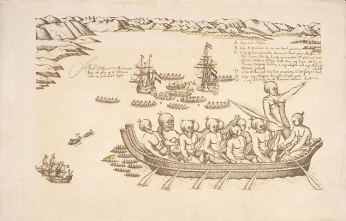 In 1642 the Dutch navigator, Abel Tasman, anchored in what is now called Golden Bay. He was at first pleased to think that he had found part of the
legendary great southern continent which the Dutch East India Company had sent him to find but then four of his ship's company were killed by Māori.
In 1642 the Dutch navigator, Abel Tasman, anchored in what is now called Golden Bay. He was at first pleased to think that he had found part of the
legendary great southern continent which the Dutch East India Company had sent him to find but then four of his ship's company were killed by Māori.
Tasman called the bay Murderers' Bay and left, never to return, although his statue now stands in bronze at Nelson's Tahunanui beach.
The next European visitors to the Nelson Tasman area were British - Captain James Cook and his crew in the Endeavour. Cook named what is now Tasman Bay, Blind Bay in 1770 but he did not land to explore the area.
 Captain Dumont D'Urville in the French corvette Astrolabe was the next known European explorer to visit Nelson in 1827. He stayed, like many of
our guests, in the Abel Tasman National Park, just across the bay from Nelson. His anchorage is consequently now known as the Astrolabe roadstead
Captain Dumont D'Urville in the French corvette Astrolabe was the next known European explorer to visit Nelson in 1827. He stayed, like many of
our guests, in the Abel Tasman National Park, just across the bay from Nelson. His anchorage is consequently now known as the Astrolabe roadstead
After several ineffectual attempts in the 1830s to control European visitors and settlers without actually establishing British law in New Zealand, the British government sent William Hobson to New Zealand to claim sovereignty and negotiate a treaty with Māori. The Treaty of Waitangi was signed in the Bay of Islands, far to the north of Nelson, on 6 February 1840. The drafting and translation of this landmark document was done hastily and inexpertly, leading to confusion and disagreement that continues to this day.
For a long time the treaty was regarded as a legal nullity but nowadays this treaty is regarded as New Zealand's foundation as a nation and is revered by Māori as a guarantee of their rights.
From 1840, European settlers streamed into New Zealand and the New Zealand Company in London planned settlements in the lower North Island and the Top of the South Island. They intended to buy cheaply from the Māori some 200 000 acres (800 square km²) which they planned to divide into one thousand lots and sell (at a considerable profit) to intending settlers.
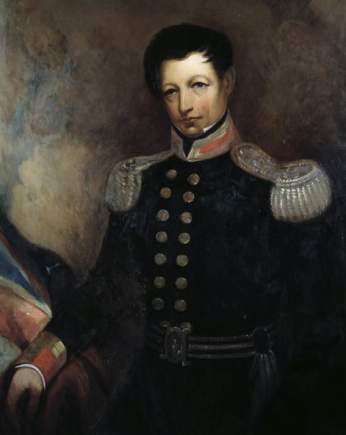 Arriving in New Zealand, they discovered that the new Governor of the colony,
William Hobson, would not give them a free hand to secure vast areas
of land from the Māori or indeed to decide where to site the colony. However, after some delay, Hobson (who, like some of the current inhabitants of Amber
House, originated from County Waterford in Ireland) allowed the Company to investigate the Tasman Bay area at the north end of the South Island.
Arriving in New Zealand, they discovered that the new Governor of the colony,
William Hobson, would not give them a free hand to secure vast areas
of land from the Māori or indeed to decide where to site the colony. However, after some delay, Hobson (who, like some of the current inhabitants of Amber
House, originated from County Waterford in Ireland) allowed the Company to investigate the Tasman Bay area at the north end of the South Island.
The Company secured from the Māori for £800 a vague and undefined area, but including present-day Nelson, Waimea, Motueka, Riwaka and Whakapuaka. This allowed the settlement to begin, but the lack of definition would prove the source of much future conflict.
The Company selected the site now occupied by the City of Nelson because it had the best harbour in the area. But it had a major drawback: it lacked suitable arable land. The City of Nelson stands right on the edge of a mountain range while the nearby Waimea Plains amount to only about 60 000 acres (243 km²), less than one third of the area required by the Company plans and by September 1841 only about one third of the lots had sold. Despite this the Colony pushed ahead..
The three colony founding ships of Whitby, Will Watch and Arrow sailed from London under the command of Captain Arthur Wakefield and entered Nelson Haven during the first week of November 1841. When the first four immigrant ships (the Fifeshire, the Mary-Ann, the Lord Auckland and the Lloyds) arrived three months later they found the town already laid out with streets, some wooden houses, tents and rough sheds.
The Bombay and Dr Samuel Hodgkinson
The Bombay, an emigrant ship of 400 tons, left Gravesend in Kent on 1st August 1842 mastered by Captain James Moore. The young
Dr Samuel Hodgkinson, aged 25 years old
was the ship's surgeon for the 134 passengers. Five passengers died and three were born during the long, four and a half month voyage but many attested to
the good medical care that they had received, before the barque Bombay arrived in Nelson Haven on 14 December 1842 with relations of the present
occupants of Amber House: 36 year old mason, Richard Power and his wife, Eleanor, 35, together with their children: 11 year old Eleanor and 8 year old Mary.
After a short stay in Nelson and Wellington the young doctor continued in the Bombay to Valparaiso in Chile where he joined the General Scott, an American whaler, bound for New Bedford. While in Australia in 1851, he decided to become a runholder in Canterbury. He took up the Deans Peaks and Doctors Hills Stations but, in the latter part of 1852, his health failed and he returned to England.
While in England Hodgkinson did much to encourage prospective emigrants and published pamphlets. He was instrumental in persuading William Rolleston to emigrate to Canterbury and he himself returned to New Zealand in 1857, settling in Parnell, Auckland.
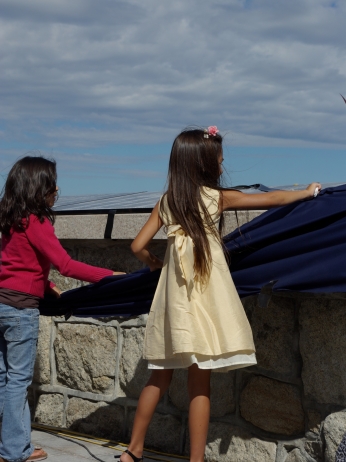 Two years later he visited
Southland where, in 1860, he acquired the Mount Fairfax Station near Riverton. From 1864 until 1870 he was a member of the Southland Provincial Council and,
as a convinced provincialist, Hodgkinson opposed Southland's reunion with Otago.
Two years later he visited
Southland where, in 1860, he acquired the Mount Fairfax Station near Riverton. From 1864 until 1870 he was a member of the Southland Provincial Council and,
as a convinced provincialist, Hodgkinson opposed Southland's reunion with Otago.
In 1868 he published Provincialism versus Centralism, a pamphlet upholding the provincial system. On 7 January 1876 he was elected member of the House of Representatives for Riverton. In Parliament he supported Sir George Grey on the provincial question, because he considered that abolition would deprive people of their opportunities to participate in local government. He was a powerful advocate for a wastelands policy to encourage closer settlement by 'immigrants of good character, both of the working and employing class', and which would also provide sufficient revenue to run the province. In 1888 he published Some Suggestions on Reform of Local Government and Decentralisation of Parliament, and advocated introducing the Canadian federal system. He favoured an elective executive and, on one occasion, failed to carry the proposal in the House by the narrow margin of two votes.
Although not a supporter of the liquor party, he was interested in the licensing question; however, he opposed the then current prohibition ideas on the grounds that these involved an infringement of personal liberty. Hodgkinson died at Richmond Grove, Southland, on 10 January 1914, leaving two sons and two daughters and just a few years short of becoming a centenarian.
Because in the 1841 migration the steerage was occupied almost entirely with free emigrants, the Examiner recorded with some satisfaction that these immigrants aboard the Bombay had "paid their passage and have the means which will enable them to farm on a small scale. Every man of this class we consider an acquisition to the settlement; and we feel assured that the moderate price at which some of the best suburban sections can be rented will insure to those who work in the right way the most ample return"
Within eighteen months the Company had sent out eighteen ships with 1052 men, 872 women and 1384 children. However, fewer than ninety of these first settlers had the capital to start as landowners.
The pressure to find more arable land became intense. To the south-east of Nelson and over an intervening mountain range lay the wide and fertile plains of the Wairau Valley. The New Zealand Company tried to claim that they had purchased the land. The Māori owners stated quite adamantly that the Wairau Valley had not formed part of the original land sale and made it clear they would resist any attempts by the settlers to occupy the area. Nelson settlers led by Arthur Wakefield and Henry Thompson attempted to do just that. This resulted in the Wairau Affray, wherein twenty-two settlers died. The subsequent Government enquiry exonerated Māori and found that the Nelson settlers had no legitimate claim to any land outside of the Tasman Bay area.German speaking immigration
 As early as 1839 the New Zealand Company had resolved to "take steps to procure German emigrants" and appointed a Mr Bockelman as agent of the Company in
Bremen. At one stage the Company made an agreement in principle to sell the Chatham Islands to the
Deutsche Colonisations Gesellschaft but were thwarted by
the British Government! However, Lord Stanley did agree to make the German colonists instant British subjects upon arrival in Nelson after being vetted in
Hamburg first.
As early as 1839 the New Zealand Company had resolved to "take steps to procure German emigrants" and appointed a Mr Bockelman as agent of the Company in
Bremen. At one stage the Company made an agreement in principle to sell the Chatham Islands to the
Deutsche Colonisations Gesellschaft but were thwarted by
the British Government! However, Lord Stanley did agree to make the German colonists instant British subjects upon arrival in Nelson after being vetted in
Hamburg first.
Most of the 140 German immigrants who arrived on the ship Sankt Pauli and formed the nucleus of the villages of Sarau (now known as Upper Moutere) and Neudorf were Lutheran Protestants with a small number of Bavarian Catholics. The trip had lasted 176 days during which time four young children had perished, seven couples had been joined in Holy Matrimony, one baby had been born and two passengers had jumped ship at a reprovisioning harbour. In 1843, the first Polish settlers were the Subritzky family. Matriarch Sophie Subritzky arrived with her extended family, and they settled for a time with the German immigrants at St Paulidorf in the Moutere valley. Ranzau was another town with high numbers of German immigrants near Nelson, being renamed Hope in 1914, but retaining the name Ranzau in several features in the town: Ranzau Road, Ranzau School, Ranzau Lutheran Church and Ranzau cemetery.
After a brief initial period of prosperity the inherent problems of lack of land and capital caught up with the Nelson settlements and they entered a prolonged period of relative depression. Organised immigration ceased until the 1850s and labourers had to accept a cut in their wages by one third. By the end of 1843 artisans and labourers began leaving Nelson and by 1846 a quarter of the immigrants had moved away.
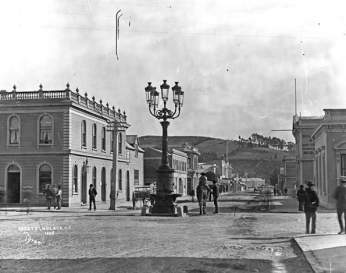 The early settler community had a wide
range of scientific, literary, farming and entrepreneurial talents and education was a high priority for Nelson settlers. Even before the settlers set foot on New
Zealand, the first New Zealand scientific and literary societies had been formed on board the Nelson-bound ships and, just 14 years after European settlement began,
Nelson College was founded - the first state school in the new colony. Nelson
College's most famous scholar was Ernest Rutherford who became 1st Baron Rutherford of Nelson, OM PC FRS - the Nobel prize winning "father of nuclear physics". Another
Nelson College pupil was Charles Munro who is credited with introducing
rugby football to New Zealand - the first match being played just a few hundred yards from Amber House in 1870.
(The first fully recorded cricket match in Nieuw Zeeland also took place a few yards from Amber House in March 1844, with Nelson beating the surveyors of the New
Zealand Land Company. The early games were played in tall hats, cravats and trousers tight at the ankle and it was customary for both teams to enjoy a big meal after
the game. You will not be surprised to hear that the first recorded women's cricket match was also played in Nelson - in 1886).
The early settler community had a wide
range of scientific, literary, farming and entrepreneurial talents and education was a high priority for Nelson settlers. Even before the settlers set foot on New
Zealand, the first New Zealand scientific and literary societies had been formed on board the Nelson-bound ships and, just 14 years after European settlement began,
Nelson College was founded - the first state school in the new colony. Nelson
College's most famous scholar was Ernest Rutherford who became 1st Baron Rutherford of Nelson, OM PC FRS - the Nobel prize winning "father of nuclear physics". Another
Nelson College pupil was Charles Munro who is credited with introducing
rugby football to New Zealand - the first match being played just a few hundred yards from Amber House in 1870.
(The first fully recorded cricket match in Nieuw Zeeland also took place a few yards from Amber House in March 1844, with Nelson beating the surveyors of the New
Zealand Land Company. The early games were played in tall hats, cravats and trousers tight at the ankle and it was customary for both teams to enjoy a big meal after
the game. You will not be surprised to hear that the first recorded women's cricket match was also played in Nelson - in 1886).
In 1862, the discovery of copper and chromite on the Dun Mountain (visible from our upstairs bathroom) saw the construction of the first railway in New Zealand built to carry the diggings to the port. (Now the track has been ripped up, it's an exhilerating walking trail and exciting mountain bike track). In 1872 construction of the Nelson to Foxhill Railway began - but New Zealands first railway's hard won links with the other lines through difficult surrounding mountainous terrain and achieved with the labour of many Chinese and Italian navvys in 1891, were severed in 1955.
Although the settlement of this region was led by immigrants from Britain and Ireland, other nationalities soon followed and our region quickly developed distinctive cultural pockets. In the 1870s, Premier Julius Vogel extended immigration assistance to southern Europeans. The government hoped to boost the growing nation with settlement, public works and forest clearing. Most of the 230 town workers who responded to the lure of free passage came from Livorno in Tuscany. They arrived between 1875 and 1876, unprepared and unsuited for the hard labour that awaited them. The first group began work on the Featherston railway, but were dismissed within a month because of disputes. The government promptly stopped assisting Italian immigrants, claiming: "they have proved utterly unfit for the work of colonisation".
Chinese immigration
The first recorded Chinese immigrant to New Zealand was Wong Ah Poo Hoc Ting (who became known as Appo Hocton or Hockton in Nelson) as early as 25 October 1842 after a five month voyage from London (nearly seven weeks before the Amber family's first pakeha relatives landed in Nelson on 14 December 1842 after a slightly shorter sea voyage from Gravesend). Appo had left China some 13 years previously at only nine years old after securing a position as a ship's boy on another British ship!
When the Thomas Harrison, one of the first New Zealand Company immigrant ships to newly-founded Nelson, tied up in Nelson Haven on 26 May 1842, several of its crew deserted. Appo, by then promoted to ship’s steward, was one of them. After hiding out in what are now called the Port Hills for a while, Appo was arrested and sentenced to thirty days in the house of correction (which had just been erected on Church Hill) on 4 November 1842.
 In 1843 Appo began working for his former ship’s surgeon, Thomas Renwick, as a housekeeper! (This position would normally have been filled by a woman - but females
were very scarce in the new colony.) It was not long before Appo had saved enough to purchase a bullock and cart and start as a carter working out of Bolton Square (near the Suter Art Gallery of today).
He successfully tendered for municipal contracts upgrading Collingwood, Milton, Nile and Trafalgar Streets and the construction of Waimea Road.
In 1843 Appo began working for his former ship’s surgeon, Thomas Renwick, as a housekeeper! (This position would normally have been filled by a woman - but females
were very scarce in the new colony.) It was not long before Appo had saved enough to purchase a bullock and cart and start as a carter working out of Bolton Square (near the Suter Art Gallery of today).
He successfully tendered for municipal contracts upgrading Collingwood, Milton, Nile and Trafalgar Streets and the construction of Waimea Road.
However, since Appo was still an alien and not a British subject he could not legally be the heritable proprietor of real property. The solution was clear: Appo successfully applied for and was granted naturalisation on 3 January 1853 - the first naturalised Chinese New Zealander.
And how times have changed. Technically, Appo was a convicted criminal that had entered New Zealand illegally and yet was naturalised as a British Subject just over 10 years after his conviction. Compare and contrast that with the position today, where Mrs Mila Amber, a citizen of Ireland, who first entered New Zealand entirely lawfully in October 1999 and then had two children born in Nelson Hospital and bought her own home in Nelson (where she lives to this day) can not be naturalised as a Kiwi some 17 years later. No, today there is no policy that allows for this even if she lives a law-abiding life in Nelson for another 5 years or 50 years (while she lives an uncertain existence on a succession of visitor permits...).
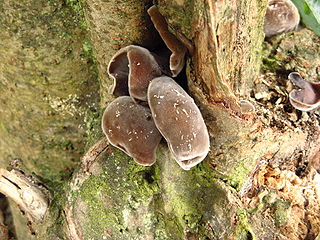 Subsequently, Appo bought land in Washington Road and what later became Hastings Street. He built several
dwelling houses, living in one and renting the other six. At the time of writing this (1 January 2016) you can still see 3 of these cottages: Numbers 16, 38 and 40
Hastings Street. Apo also dealt in scrap metal and exported the Auricularia polytricha fungus (known in the Philippines as tenga ng daga, meaning
"rat's ear", due to its appearance and then, as now, found growing locally on fallen trees), to his native China where it was used in cooking.
Subsequently, Appo bought land in Washington Road and what later became Hastings Street. He built several
dwelling houses, living in one and renting the other six. At the time of writing this (1 January 2016) you can still see 3 of these cottages: Numbers 16, 38 and 40
Hastings Street. Apo also dealt in scrap metal and exported the Auricularia polytricha fungus (known in the Philippines as tenga ng daga, meaning
"rat's ear", due to its appearance and then, as now, found growing locally on fallen trees), to his native China where it was used in cooking.
In July 1856, Appo married his widowed neighbour, Jennifer Rowlings. Local opinion was that her five year old son, William, was Appo’s natural child. Jennifer died in 1865 and, six months after her death, Appo married Ellen Snook and they had three children, Appo Louis, Albert Ah Lina and Eirena Jane. In 1887, they also adopted a baby girl, Olive Clara Schroder.
This then was the family that, in 1876, moved 20 miles to Dovedale and began farming at Brandy Creek - the area eventually becoming known as Chinatown. Appo's youngest son, Albert, was accidentally shot dead by his brother Louis while hunting rabbits in 1879 but the rest of Appo's children married and gratefully settled into homes Appo built for them.
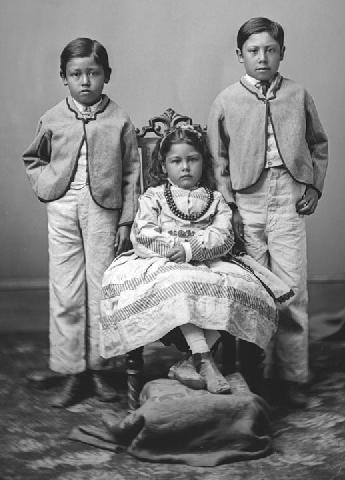 Appo seems to have been highly regarded as one of Nelson's pioneers and, in 1887, was one of eighty four invited guests who attended a settlers’ luncheon
commemorating the Golden Jubilee of Queen Victoria.
Appo seems to have been highly regarded as one of Nelson's pioneers and, in 1887, was one of eighty four invited guests who attended a settlers’ luncheon
commemorating the Golden Jubilee of Queen Victoria.
Not surprisingly, considering the brief history outlined above, Appo's date of birth was never verified so his age at death, on 26 September 1920, varies from 98 to 103, depending on which family story or document is used. New Zealand’s first Chinese immigrant and first naturalised Chinese New Zealander is buried alongside other descendants in Dovedale Cemetery. By 2000 he had 1600 living descendants throughout the length and breadth of New Zealand
Edward Gibbon Wakefield, known for his success in settling New Zealand with British small farmers, had formulated detailed plans to bring in Chinese to provide valuable labour as servants, shepherds, stock-keepers, mechanics and manual workers. But he had to drop this idea when opponents in 1853 labelled his scheme a conspiracy to overrun the colony with ‘Coolie-slaves’ who were ‘ignorant, slavish, and treacherous’.
In 1881 the first formal barriers to immigration were set up, to hold back Chinese immigrants. The Chinese Immigrants Act of 1881 imposed a poll tax of £10 per Chinese person and restricted the numbers able to enter the country to one person per ten tonnes of ship cargo. In 1896 the tax was lifted to £100 per person, one Chinese per 200 tonnes of ship cargo and there were further restrictions on the numbers of Chinese able to enter New Zealand.
In 1908, Chinese people had to put a thumbprint on their Certificates of Registration before leaving the country - no other ethnic group had to leave thumbprints. Chinese people were deprived of their right to naturalisation in 1908 and this was not rescinded until 1951 - no other ethnic group was deprived of this right. A reading test in English was introduced - other immigrants had only a writing test in their own language. Even in 1935 when entry permits were introduced after a suspension of 15 years for reunification of family and partners of Chinese people, they were severely restricted.
On Wednesday, February 13, 2002, Prime Minister Helen Clark apologised to the Chinese New Zealanders who paid a poll tax and suffered other discrimination imposed by statute and to their descendants. She hailed the Chinese community in New Zealand as a "significant contributor" to New Zealand. "Modern New Zealand has a bicultural foundation, and today is home to many peoples. It is important that we value, honour and respect all our communities and see our diversity as a great strength," she said.
Italian emigration
By the 1920s, it became harder for anyone who was not British to get in. Russians, Italians, Japanese, Africans - people from all over the globe faced restrictions. There was a "White New Zealand" policy in practice, if not in name. However, at the end of the nineteenth century, after a steady tightening of immigration policy, government policy relaxed a little and allowed southern Europeans to nominate relatives up to the level of first cousin cosanguinity. Pathfinders would encourage their family to come, finding them work and lodgings (and sometimes the price of the passage). Over time, close-knit communities developed, sharing bonds of kinship and a common village or region back in Europe.
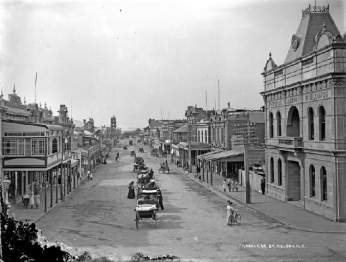 Giacomo Persico, of Massa Lubrense near Naples in Italy, came to Nelson in the early 1900s, and a smaller chain of immigrants, originating in Potenza began
in 1915.
Giacomo Persico, of Massa Lubrense near Naples in Italy, came to Nelson in the early 1900s, and a smaller chain of immigrants, originating in Potenza began
in 1915.
These two Italian groups settled in our area of "The Wood", which became a major tomato-growing area in glasshouses. All of the glasshouses have now been demolished as the price of oil soared and Nelson central city land became too valuable and Nelson City Council relaxed the regulations on the sub-division of plots.
The first Italian to reach New Zealand shores had been Antonio Ponto, who sailed on the Endeavour with Captain James Cook in 1769.
One of the earliest settlers was Salvatore Cimino, a shipping trader from Capri who arrived about 1839. He was married twice, to New Zealand women, and had close ties with Māori, including Te Rauparaha and settled in Wellington.The Missionary Church in Nelson
adapted from a piece by Russell J. Smith, MTh DipMgtThe first proclamation of the Gospel in New Zealand was by the Reverend Samuel Marsden, in the Bay of Islands, on Christmas Day, 1814. Although Marsden returned to New South Wales, he left an initial trio of missionaries and their families to establish a small settlement, and this number was slowly added to by several others over the years. While the mission struggled for the first few years, by the late 1820’s and 30’s a considerable number of Māoris had accepted the Christian message and many churches had been established.
Christianity spread through New Zealand as much by Māori evangelists who travelled from place to place and then established Christian communities, as by the preaching of the early missionaries. This meant that, up until 1841, the Church in New Zealand was predominantly a Māori Church.
When Bishop George Augustus Selwyn arrived he attempted to embrace missions and also provide ministry to European settlers. In many ways this tension still exists; the challenge of embracing something new against that of maintaining existing structures which are nonetheless still deeply meaningful to those participating in them.
The settlers wanted a church that was essentially transplanted from Great Britain, while the missionary church was a vibrant expression of new found faith among the Maori. Although Selwyn had learnt to speak Te Reo and was able to preach to Māori in their own language immediately upon his arrival, he was never able to enjoy the same kind of relationship that Marsden and the CMS missionaries had. By the 1850s he had concluded that “it was harder than he thought to plant the seeds of a new religion in the hearts of the Maori and harder still to unite settler and Maori in a single church …” In the end he devoted much of his energy towards establishing a church structure that suited the new settlers. This meant that it followed the English Parish system and made no real provision to incorporate any positive aspects of the missionary church.
Nelson was settled by the New Zealand Company whose stated aim was to transplant English society in all its entirety to the new colony. Hence there was planning right from the outset to provide for churches to be established. The site on which Christ Church Cathedral now stands was chosen from the inception. Even though it was first used as the base for the Company barracks it was not long before a place of worship was put in place.
However, Christianity had certainly taken root among many of the Māori people living here before any European settlers arrived. When the first European
missionaries came to the top of the south around 1838, they found that there were already many Christians. Two anecdotes from the early establishment of the
settlement of Nelson by the New Zealand Company in 1842 illustrate the presence of this Māori Christian community that was already present:
The Lord Auckland was one of the later ships to arrive carrying the early settlers to the town of Nelson. It brought some of the wealthier passengers. One of them,
Alfred Fell, decided that a flat area midway between the new port and the township would be an ideal place for a business site. He persuaded a group of his fellow
passengers to stay with him there and camp as a group so as to be protected from any molestation by native Māori. They discovered quite soon that any fears they
had of this were completely unfounded. The place was named Lord Auckland Point, although later the “Lord” was omitted. They slept the night under some loose planks
until they could borrow a Company tent. However, they had noisy neighbours, “their ears were alternatively assailed by carousing of sailors in the tideway
grogshop, and by the prayers and hymn singing of the Māoris in a nearby encampment.”
Earlier when Captain Arthur Wakefield arrived with the first contingent of settlers, after first erecting a pole to hoist the Union Jack, he pitched a tent at an area
at the bottom of what is now Richardson Street. It was a Sunday morning so he conducted a service. Māoris who had come from Wakapuaka also held a service on the
hillside, but they were surprised when the settlers immediately went to work after their service. They had been taught to be strict Sabbatarians with no business
conducted on a Sunday.
The land at Auckland Point (Matangi Awhio) had been a meeting point for Maori for many generations. So when the Reverend Octavius Hadfield came to Nelson in March 1842 he held a service there first for the Māori Christians and then went on to Pikimai for a service. Many of the Māori at the first service travelled with Hadfield to Church Hill to join the service there, held in the New Zealand Company’s barracks.
Gallipoli
Not least because of the slaughter caused by inept generalship and poor planning, the invasion of the Ottoman Turkish empire by British and French imperial troops
on 25 April 1915 is remembered more in New Zealand and Australia than in Britain or Ireland. Many Australians already know of the disproportionately larger
contribution made by New Zealand both in terms of volunteers and casualties per head of home nation population, but few realise that more than 4000 Irish soldiers
died in Turkey - both in the 10th (Irish) Division and in Australian uniform - compared to 2770 Kiwi deaths:
Field of Bones: An Irish Division at Gallipoli
The Tenth (Irish) Division in Gallipoli by Bryan Cooper
The Tenth (Irish) Division in Gallipoli by Bryan Cooper (full text)
